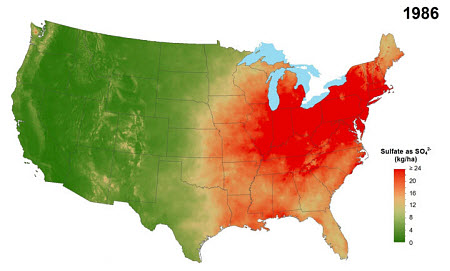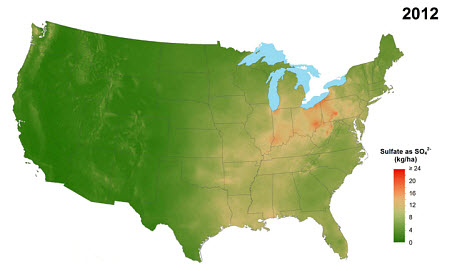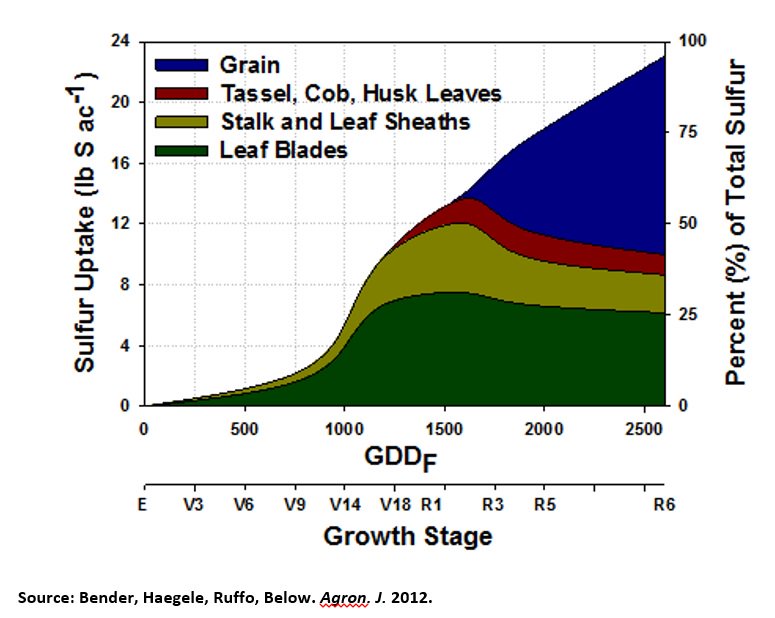About Your Fields March 26, 2018
In this issue:
1. Next up on the Menu Manganese and Sulphur
2. News That Caught Our Eye
Next Up on the Menu, Manganese and Sulphur
This week we will continue our discussion of essential elements by covering how Manganese and Sulphur play a role in crop production. It wasn't that long ago that both of these elements were not thought of very much. Due to different factors they both have become necessary to manage a little more closely today. We will start off our discussion with sulphur one of the secondary macronutrient necessary for protein synthesis within the plant. Before the amendments to the Clean Air Act were signed into law on November 15, 1990, we got a lot of the sulphur needed for plants from pollution. Since that time the amount of sulphur deposited onto the ground from the atmosphere has dramatically been reduced. Look at the diagrams below at the differences between the sulphur level in 1986 and 2012:


Notice the dramatic differences in the amount of sulphur deposited throughout what is known as "The Rust Belt", areas of a lot of industrial production. This area just happens to coincide with where a lot of our nation's corn and soybeans are produced. Due to this clean up of our industrial sites to make them cleaner and better on the environment, farmer's need to start managing sulphur levels in their fields. The easiest way for this would be to just apply elemental sulphur to the field, but this takes a little more planning. If you apply elemental sulphur in the fall with you potassium and phosphorus, it will not be available for the plants next spring. It will be fully available the following year to that crop. If you look at the sulphur use curve in corn you will see that it is necessary all throughout the growing season.

If you are wanting to put sulphur out this spring for this year's crop, you will need to change from an elemental form to a sulphate form of sulphur. We have access to several different products (ammonium sulfate, thiosol, etc) that would fill this particular need, just call one of the agronomists at Akron and we could help you decide what is best for your situation.
Next we will discuss the role manganese (Mn) plays in crop production. Manganese is an essential micronutrient necessary for photosynthesis in the plant. When you look at Mulder's Globe you will see that manganese plays a role in Potassium (K) and iron (Fe). It is because of this relationship that manganese deficiency would hurt soybeans more than corn. Typically you will find a soil deficient in manganese if it is sandy, has a higher level of organic material and a pH of 6 or above, or a highly weathered tropical soil. Normally we do not see deficiency symptoms in plants in our geography, but this started to change in the mid to late 1990's. What happened at this time to start hurting manganese availability in our crops? In a word "Glyphosate". With the introduction of glyphosate resistant crops, we have seen a problem with the availability of manganese. Now don't get me wrong, even though the value of glyphosate's ability to control problem weeds effectively and economically far outweighed what you could have lost due to lack of manganese, it was still there. If you would like to learn more, click on this link Manganese and Glyphosate's Relationship in Crop Production. Glyphosate affects manganese metabolism in the plant when it is applied. One way to correct this problem is to add a foliar source of manganese to your program when you are making an application of glyphosate. Research has show it would be ideally suited to do this about a week to 10 days after the application, but practicality says we should add it to the mix with the glyphosate. One product that we have used in soybeans is ENC plus Mn. This product will give you extra manganese along with other essential micronutrients and vitamins needed at this time. If you have any questions or concerns give one of the Agronomist's at Akron a call and discuss it with them.
News That Caught My Eye
I know that as I am writing this many of us have several inches of snow on the ground, but last week several of you started spring field work. Several of you called in and asked about putting down your residual herbicide at that time. The thing that you need to remember is that just like corn and soybeans, weeds need a certain amount of heat units to emerge. Here is a link to an article written in April, 2000 by Dr. Aaron Hager in which he talks about the necessity of knowing when to look for a weed to emerge Weed Emergence Article by Dr. Aaron Hager. We do not want to go out too early and waste your money on a residual if it won't be around when the weeds we want to hold back start to emerge. If you want to know when certain weeds will be emerging click on this link to a poster that shows how many Growing Degree Units are needed to get a particular weed species to germinate Weed Emergence Poster. I know that as the calender is getting closer to April we all want to be getting stuff done, but as I have said before "You only have one chance to do it right the first time". Let's start this year off on the best foot possible if we can.